Falls Prevention Among Elderly Individuals: PHAA Policy and Strategies
VerifiedAdded on 2021/05/31
|21
|3680
|29
Report
AI Summary
This report focuses on falls prevention among elderly individuals, examining the Public Health Association of Australia (PHAA) policy and related strategies. It begins by defining falls and highlighting the associated risks and statistics, including those from the World Health Organization (WHO). The report then delves into the PHAA's policy, outlining its principles, recommendations, and actions to reduce fall-related injuries. Key areas covered include prevention strategies in various settings (hospitals, residential, and home/community), implementation plans, and evaluation methods. The document emphasizes the importance of a coordinated national response, evidence-based approaches, and collaborative efforts across healthcare disciplines to address the growing challenges of an aging population and the associated costs of falls. The report also suggests updates to the PHAA guidelines for more effective implementation of fall prevention strategies.
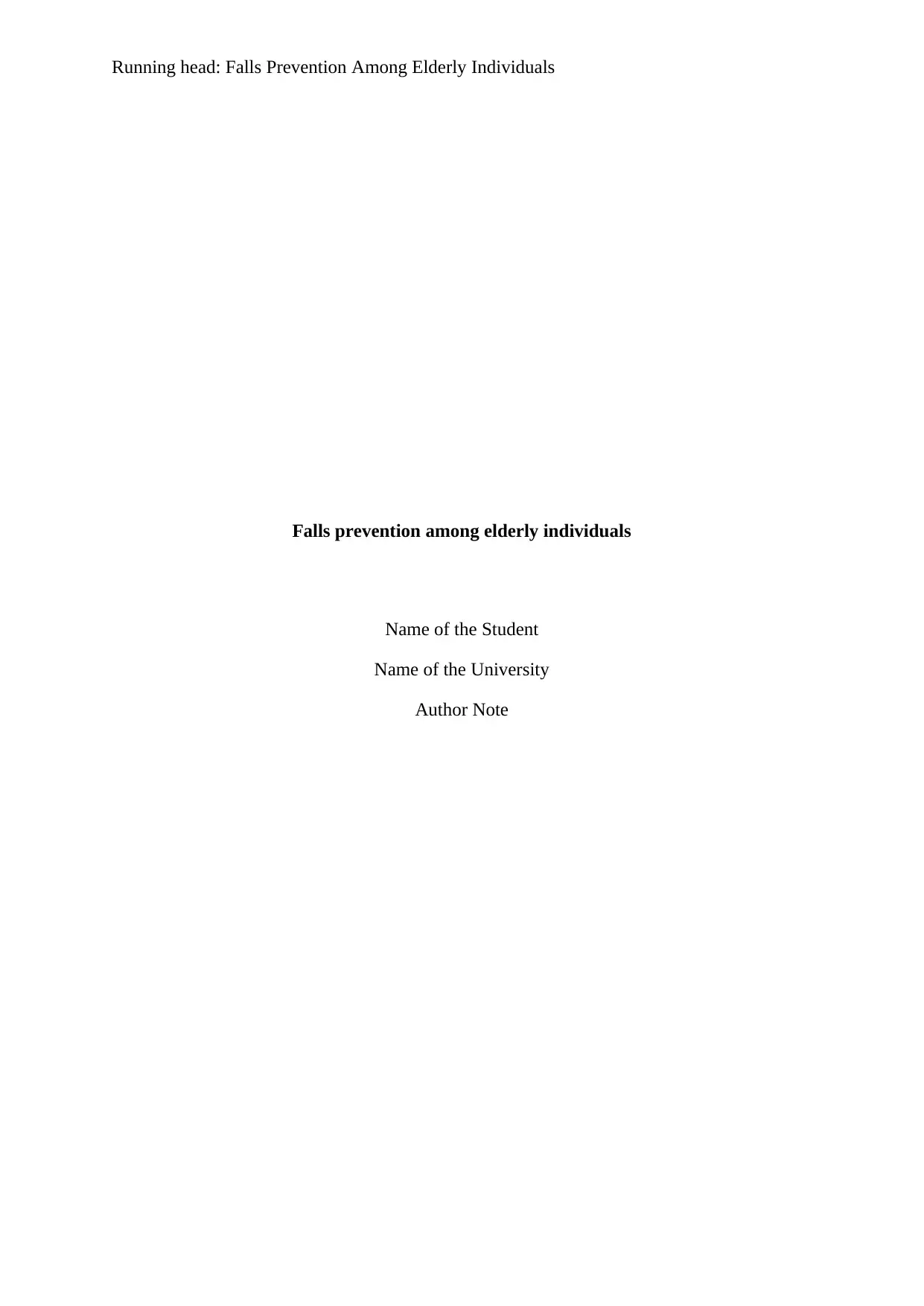
Running head: Falls Prevention Among Elderly Individuals
Falls prevention among elderly individuals
Name of the Student
Name of the University
Author Note
Falls prevention among elderly individuals
Name of the Student
Name of the University
Author Note
Paraphrase This Document
Need a fresh take? Get an instant paraphrase of this document with our AI Paraphraser

1Falls Prevention among elderly individuals
Contents
Background:...............................................................................................................................5
PHAA: Fall Injury Prevention in Older People Policy..........................................................7
Policy Statement:.......................................................................................................................7
PHAA Principles:.......................................................................................................................8
PHAA Recommendations for Strategies:...................................................................................9
PHAA recommendations for Actions:.....................................................................................11
Recommended Updates:...........................................................................................................12
In A Hospital Setting:...........................................................................................................13
Prevention Strategies:.......................................................................................................13
Education Strategies:........................................................................................................14
Intervention Strategies:....................................................................................................14
Residential Settings:.............................................................................................................15
Education Strategies:........................................................................................................15
Intervention Strategies:....................................................................................................16
Home and Community Setting:............................................................................................16
Prevention strategy:..........................................................................................................16
Education Strategy:..........................................................................................................17
Intervention Strategies:....................................................................................................17
Interface Settings:.............................................................................................................17
Implementation Plan:...........................................................................................................17
Contents
Background:...............................................................................................................................5
PHAA: Fall Injury Prevention in Older People Policy..........................................................7
Policy Statement:.......................................................................................................................7
PHAA Principles:.......................................................................................................................8
PHAA Recommendations for Strategies:...................................................................................9
PHAA recommendations for Actions:.....................................................................................11
Recommended Updates:...........................................................................................................12
In A Hospital Setting:...........................................................................................................13
Prevention Strategies:.......................................................................................................13
Education Strategies:........................................................................................................14
Intervention Strategies:....................................................................................................14
Residential Settings:.............................................................................................................15
Education Strategies:........................................................................................................15
Intervention Strategies:....................................................................................................16
Home and Community Setting:............................................................................................16
Prevention strategy:..........................................................................................................16
Education Strategy:..........................................................................................................17
Intervention Strategies:....................................................................................................17
Interface Settings:.............................................................................................................17
Implementation Plan:...........................................................................................................17
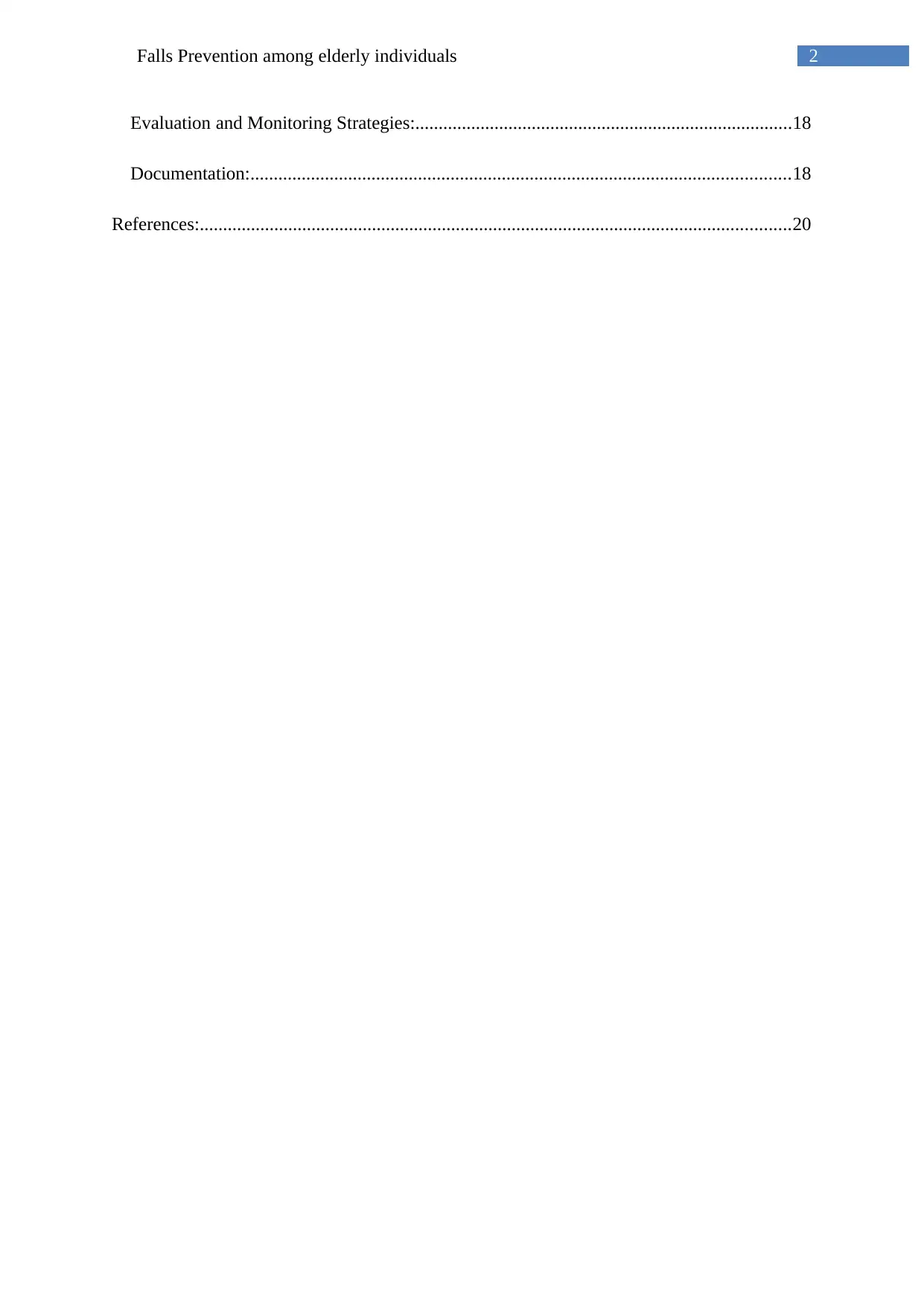
2Falls Prevention among elderly individuals
Evaluation and Monitoring Strategies:.................................................................................18
Documentation:....................................................................................................................18
References:...............................................................................................................................20
Evaluation and Monitoring Strategies:.................................................................................18
Documentation:....................................................................................................................18
References:...............................................................................................................................20
⊘ This is a preview!⊘
Do you want full access?
Subscribe today to unlock all pages.

Trusted by 1+ million students worldwide

3Falls Prevention among elderly individuals
NAME OF DOCUMENT Fall Injury Prevention in Older People Policy
TYPE OF DOCUMENT Policy
DOCUMENT NUMBER NA
DATE OF PUBLICATION 1991
RISK RATING High
REVIEW DATE
Documents are to be reviewed a
maximum of three years from date of
issue
2015
FORMER REFERENCE(S)
Documents that are replaced by this one
NA
EXECUTIVE SPONSOR or
EXECUTIVE CLINICAL
SPONSOR
Public Health Association of Australia
AUTHOR Richard Franklin & Lyndal Bugeja, Co-Convenors,
NAME OF DOCUMENT Fall Injury Prevention in Older People Policy
TYPE OF DOCUMENT Policy
DOCUMENT NUMBER NA
DATE OF PUBLICATION 1991
RISK RATING High
REVIEW DATE
Documents are to be reviewed a
maximum of three years from date of
issue
2015
FORMER REFERENCE(S)
Documents that are replaced by this one
NA
EXECUTIVE SPONSOR or
EXECUTIVE CLINICAL
SPONSOR
Public Health Association of Australia
AUTHOR Richard Franklin & Lyndal Bugeja, Co-Convenors,
Paraphrase This Document
Need a fresh take? Get an instant paraphrase of this document with our AI Paraphraser
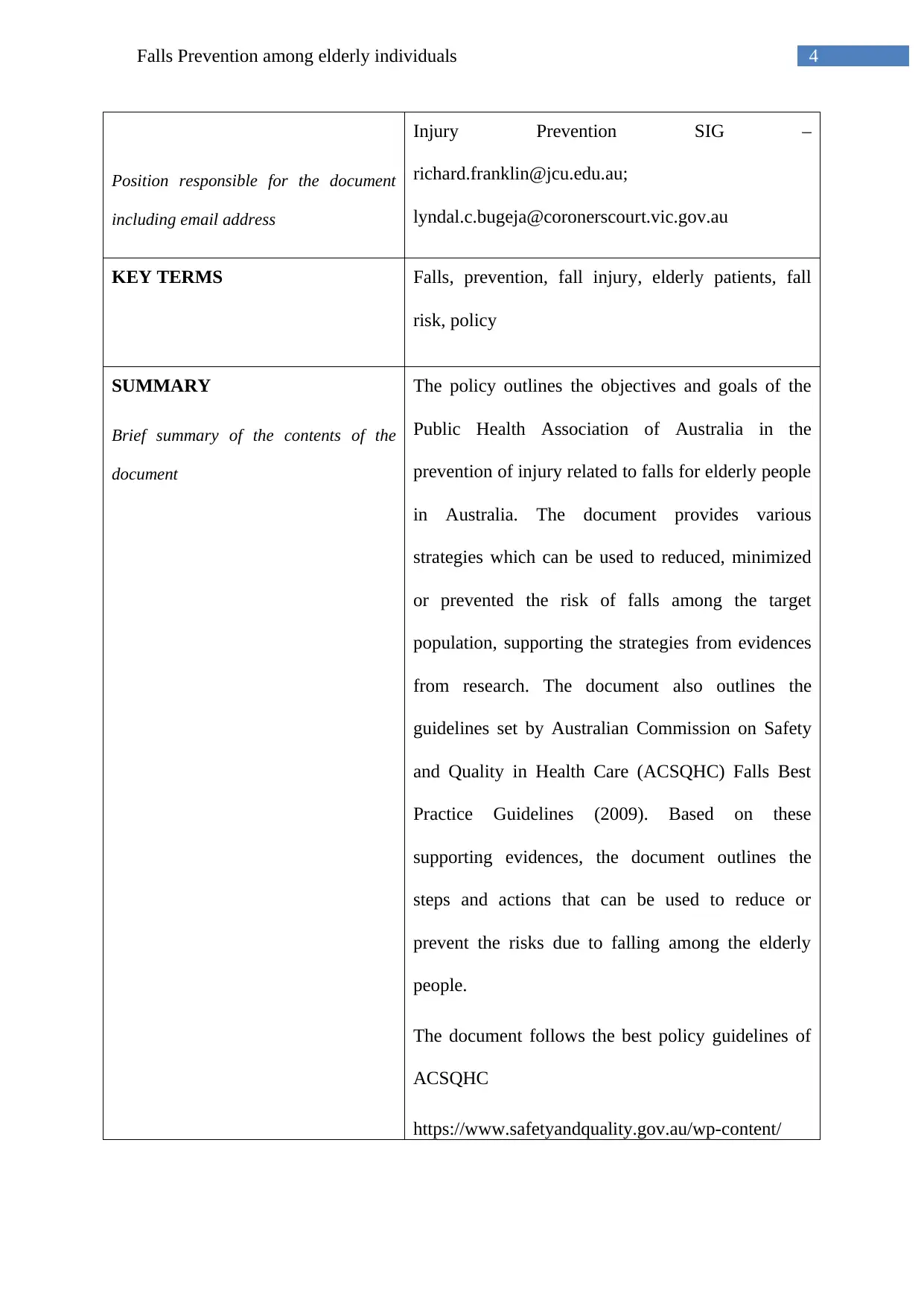
4Falls Prevention among elderly individuals
Position responsible for the document
including email address
Injury Prevention SIG –
richard.franklin@jcu.edu.au;
lyndal.c.bugeja@coronerscourt.vic.gov.au
KEY TERMS Falls, prevention, fall injury, elderly patients, fall
risk, policy
SUMMARY
Brief summary of the contents of the
document
The policy outlines the objectives and goals of the
Public Health Association of Australia in the
prevention of injury related to falls for elderly people
in Australia. The document provides various
strategies which can be used to reduced, minimized
or prevented the risk of falls among the target
population, supporting the strategies from evidences
from research. The document also outlines the
guidelines set by Australian Commission on Safety
and Quality in Health Care (ACSQHC) Falls Best
Practice Guidelines (2009). Based on these
supporting evidences, the document outlines the
steps and actions that can be used to reduce or
prevent the risks due to falling among the elderly
people.
The document follows the best policy guidelines of
ACSQHC
https://www.safetyandquality.gov.au/wp-content/
Position responsible for the document
including email address
Injury Prevention SIG –
richard.franklin@jcu.edu.au;
lyndal.c.bugeja@coronerscourt.vic.gov.au
KEY TERMS Falls, prevention, fall injury, elderly patients, fall
risk, policy
SUMMARY
Brief summary of the contents of the
document
The policy outlines the objectives and goals of the
Public Health Association of Australia in the
prevention of injury related to falls for elderly people
in Australia. The document provides various
strategies which can be used to reduced, minimized
or prevented the risk of falls among the target
population, supporting the strategies from evidences
from research. The document also outlines the
guidelines set by Australian Commission on Safety
and Quality in Health Care (ACSQHC) Falls Best
Practice Guidelines (2009). Based on these
supporting evidences, the document outlines the
steps and actions that can be used to reduce or
prevent the risks due to falling among the elderly
people.
The document follows the best policy guidelines of
ACSQHC
https://www.safetyandquality.gov.au/wp-content/

5Falls Prevention among elderly individuals
uploads/2012/01/Guidelines-COMM.pdf
Background:
A fall can be understood as an incident which causes an individual coming at rest
accidentally on the ground, floor or a lower level, according to the definition by the World
Health Organization (WHO). The WHO statistics shows that every year 646,000 people die
due to injuries caused by falling. Adults who are 65 years or older are at the highest risk of
falling, and receiving a fatal injury due to it. Moreover, every year there are 37.3 million
incidents of falls, which require medical attention. The WHO recommends that preventative
strategies should focus on education, training and developing safe environments as well as on
studies on fall and fall prevention and devise effective policies to alleviate the risk of falling
(who.int 2018). The risks of falling also increases with age, which is supported by the
Canadian Community Health Survey in Canada on people above 65 years of age. The
statistics (published by WHO) shows that the risk for fall related injuries increased
progressively among the age groups 65-69 (35 cases), 70-74 (46 cases), 75-79 (66 cases) and
above 80 (76 cases). The statistics also showed comparatively higher risks of injuries related
to falls among women, compared to men (who.int, 2018).
uploads/2012/01/Guidelines-COMM.pdf
Background:
A fall can be understood as an incident which causes an individual coming at rest
accidentally on the ground, floor or a lower level, according to the definition by the World
Health Organization (WHO). The WHO statistics shows that every year 646,000 people die
due to injuries caused by falling. Adults who are 65 years or older are at the highest risk of
falling, and receiving a fatal injury due to it. Moreover, every year there are 37.3 million
incidents of falls, which require medical attention. The WHO recommends that preventative
strategies should focus on education, training and developing safe environments as well as on
studies on fall and fall prevention and devise effective policies to alleviate the risk of falling
(who.int 2018). The risks of falling also increases with age, which is supported by the
Canadian Community Health Survey in Canada on people above 65 years of age. The
statistics (published by WHO) shows that the risk for fall related injuries increased
progressively among the age groups 65-69 (35 cases), 70-74 (46 cases), 75-79 (66 cases) and
above 80 (76 cases). The statistics also showed comparatively higher risks of injuries related
to falls among women, compared to men (who.int, 2018).
⊘ This is a preview!⊘
Do you want full access?
Subscribe today to unlock all pages.

Trusted by 1+ million students worldwide
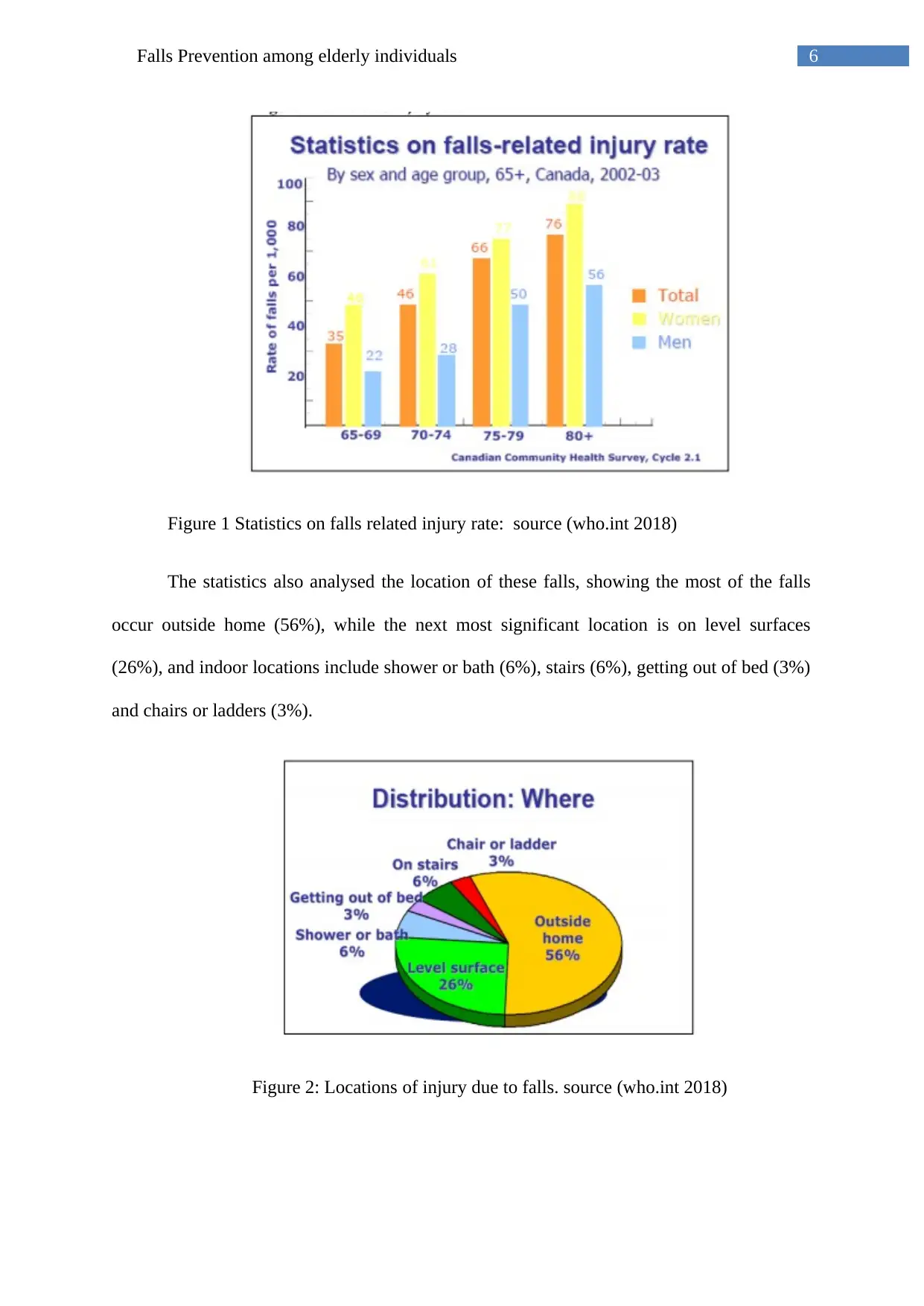
6Falls Prevention among elderly individuals
Figure 1 Statistics on falls related injury rate: source (who.int 2018)
The statistics also analysed the location of these falls, showing the most of the falls
occur outside home (56%), while the next most significant location is on level surfaces
(26%), and indoor locations include shower or bath (6%), stairs (6%), getting out of bed (3%)
and chairs or ladders (3%).
Figure 2: Locations of injury due to falls. source (who.int 2018)
Figure 1 Statistics on falls related injury rate: source (who.int 2018)
The statistics also analysed the location of these falls, showing the most of the falls
occur outside home (56%), while the next most significant location is on level surfaces
(26%), and indoor locations include shower or bath (6%), stairs (6%), getting out of bed (3%)
and chairs or ladders (3%).
Figure 2: Locations of injury due to falls. source (who.int 2018)
Paraphrase This Document
Need a fresh take? Get an instant paraphrase of this document with our AI Paraphraser
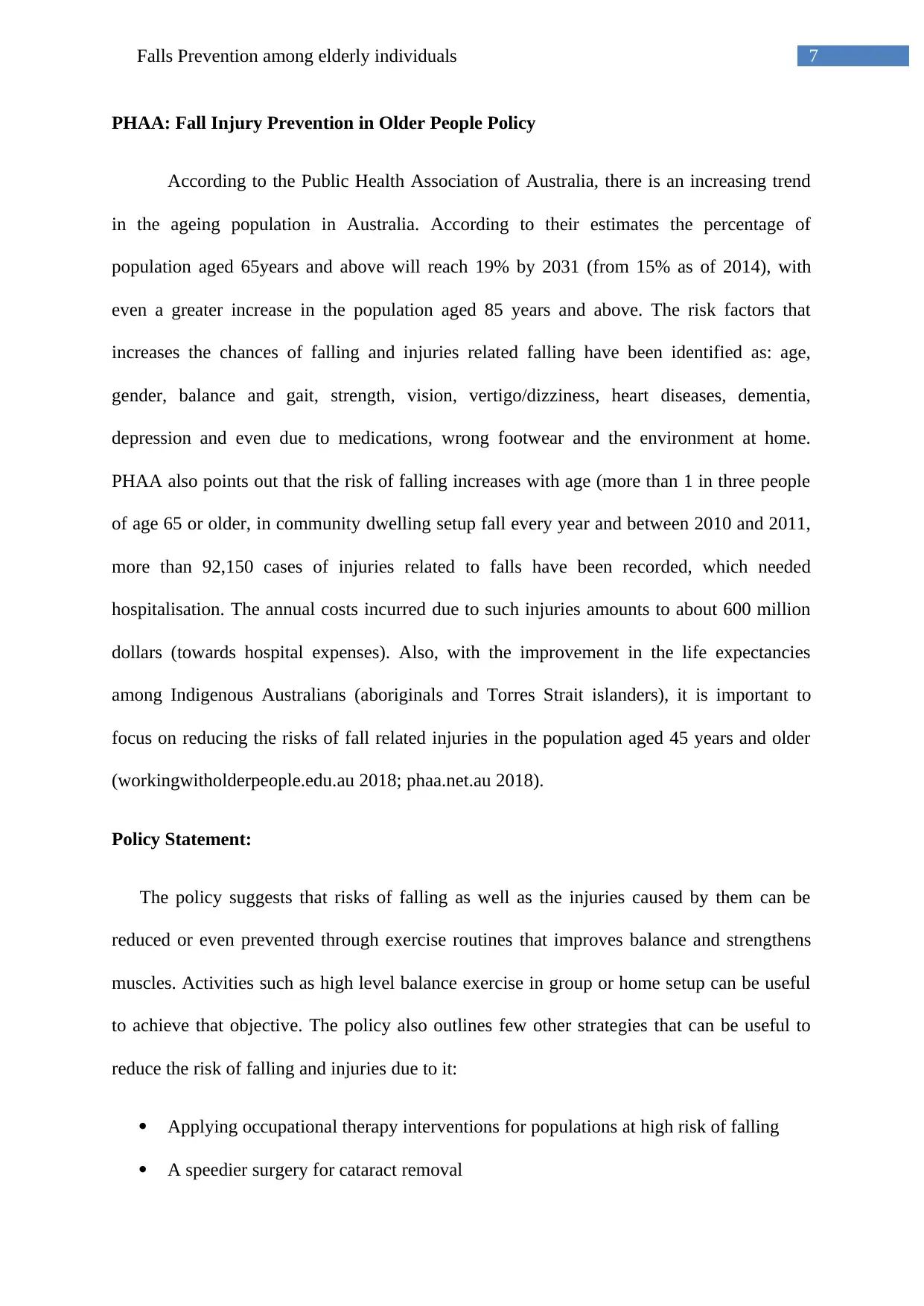
7Falls Prevention among elderly individuals
PHAA: Fall Injury Prevention in Older People Policy
According to the Public Health Association of Australia, there is an increasing trend
in the ageing population in Australia. According to their estimates the percentage of
population aged 65years and above will reach 19% by 2031 (from 15% as of 2014), with
even a greater increase in the population aged 85 years and above. The risk factors that
increases the chances of falling and injuries related falling have been identified as: age,
gender, balance and gait, strength, vision, vertigo/dizziness, heart diseases, dementia,
depression and even due to medications, wrong footwear and the environment at home.
PHAA also points out that the risk of falling increases with age (more than 1 in three people
of age 65 or older, in community dwelling setup fall every year and between 2010 and 2011,
more than 92,150 cases of injuries related to falls have been recorded, which needed
hospitalisation. The annual costs incurred due to such injuries amounts to about 600 million
dollars (towards hospital expenses). Also, with the improvement in the life expectancies
among Indigenous Australians (aboriginals and Torres Strait islanders), it is important to
focus on reducing the risks of fall related injuries in the population aged 45 years and older
(workingwitholderpeople.edu.au 2018; phaa.net.au 2018).
Policy Statement:
The policy suggests that risks of falling as well as the injuries caused by them can be
reduced or even prevented through exercise routines that improves balance and strengthens
muscles. Activities such as high level balance exercise in group or home setup can be useful
to achieve that objective. The policy also outlines few other strategies that can be useful to
reduce the risk of falling and injuries due to it:
Applying occupational therapy interventions for populations at high risk of falling
A speedier surgery for cataract removal
PHAA: Fall Injury Prevention in Older People Policy
According to the Public Health Association of Australia, there is an increasing trend
in the ageing population in Australia. According to their estimates the percentage of
population aged 65years and above will reach 19% by 2031 (from 15% as of 2014), with
even a greater increase in the population aged 85 years and above. The risk factors that
increases the chances of falling and injuries related falling have been identified as: age,
gender, balance and gait, strength, vision, vertigo/dizziness, heart diseases, dementia,
depression and even due to medications, wrong footwear and the environment at home.
PHAA also points out that the risk of falling increases with age (more than 1 in three people
of age 65 or older, in community dwelling setup fall every year and between 2010 and 2011,
more than 92,150 cases of injuries related to falls have been recorded, which needed
hospitalisation. The annual costs incurred due to such injuries amounts to about 600 million
dollars (towards hospital expenses). Also, with the improvement in the life expectancies
among Indigenous Australians (aboriginals and Torres Strait islanders), it is important to
focus on reducing the risks of fall related injuries in the population aged 45 years and older
(workingwitholderpeople.edu.au 2018; phaa.net.au 2018).
Policy Statement:
The policy suggests that risks of falling as well as the injuries caused by them can be
reduced or even prevented through exercise routines that improves balance and strengthens
muscles. Activities such as high level balance exercise in group or home setup can be useful
to achieve that objective. The policy also outlines few other strategies that can be useful to
reduce the risk of falling and injuries due to it:
Applying occupational therapy interventions for populations at high risk of falling
A speedier surgery for cataract removal
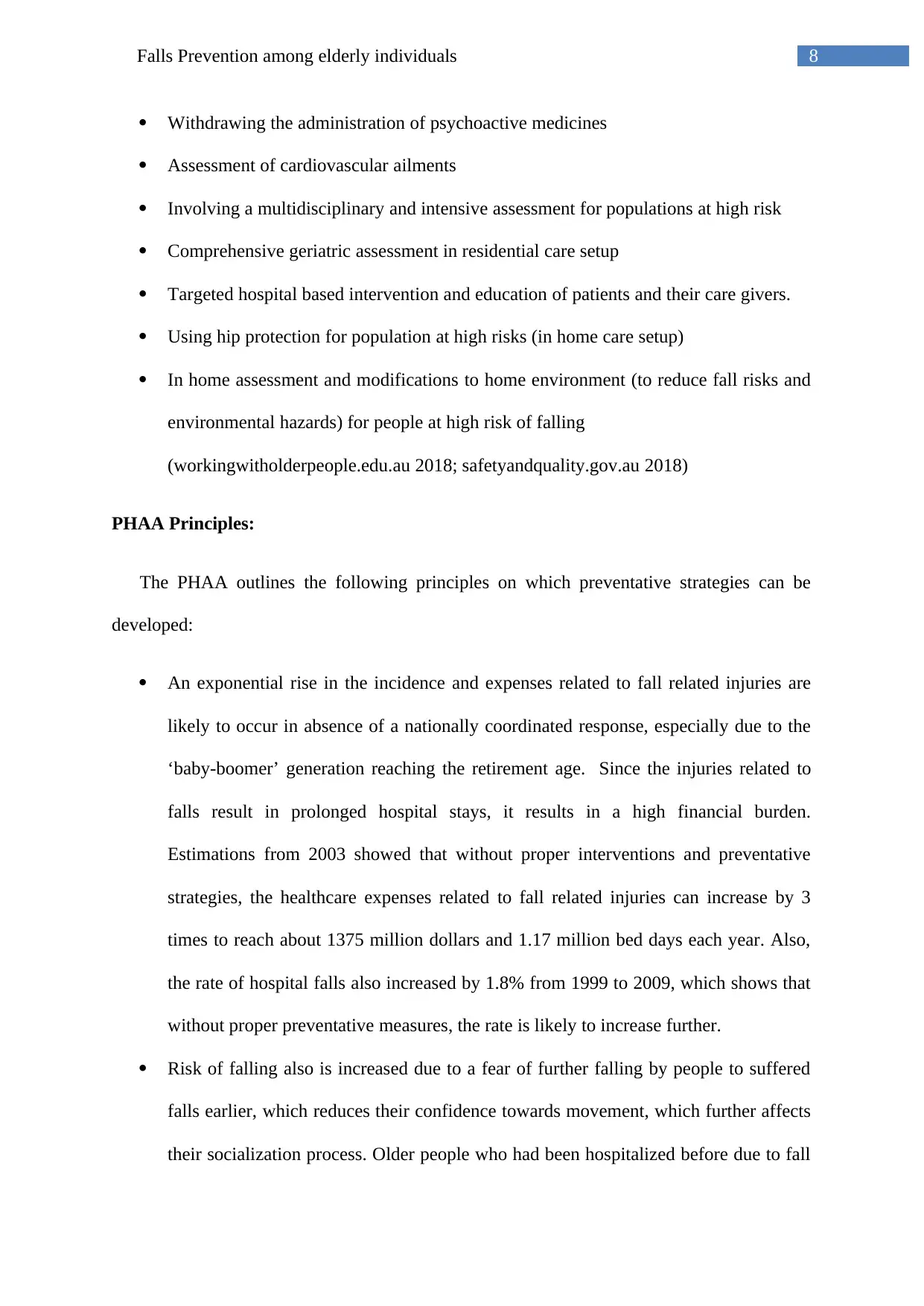
8Falls Prevention among elderly individuals
Withdrawing the administration of psychoactive medicines
Assessment of cardiovascular ailments
Involving a multidisciplinary and intensive assessment for populations at high risk
Comprehensive geriatric assessment in residential care setup
Targeted hospital based intervention and education of patients and their care givers.
Using hip protection for population at high risks (in home care setup)
In home assessment and modifications to home environment (to reduce fall risks and
environmental hazards) for people at high risk of falling
(workingwitholderpeople.edu.au 2018; safetyandquality.gov.au 2018)
PHAA Principles:
The PHAA outlines the following principles on which preventative strategies can be
developed:
An exponential rise in the incidence and expenses related to fall related injuries are
likely to occur in absence of a nationally coordinated response, especially due to the
‘baby-boomer’ generation reaching the retirement age. Since the injuries related to
falls result in prolonged hospital stays, it results in a high financial burden.
Estimations from 2003 showed that without proper interventions and preventative
strategies, the healthcare expenses related to fall related injuries can increase by 3
times to reach about 1375 million dollars and 1.17 million bed days each year. Also,
the rate of hospital falls also increased by 1.8% from 1999 to 2009, which shows that
without proper preventative measures, the rate is likely to increase further.
Risk of falling also is increased due to a fear of further falling by people to suffered
falls earlier, which reduces their confidence towards movement, which further affects
their socialization process. Older people who had been hospitalized before due to fall
Withdrawing the administration of psychoactive medicines
Assessment of cardiovascular ailments
Involving a multidisciplinary and intensive assessment for populations at high risk
Comprehensive geriatric assessment in residential care setup
Targeted hospital based intervention and education of patients and their care givers.
Using hip protection for population at high risks (in home care setup)
In home assessment and modifications to home environment (to reduce fall risks and
environmental hazards) for people at high risk of falling
(workingwitholderpeople.edu.au 2018; safetyandquality.gov.au 2018)
PHAA Principles:
The PHAA outlines the following principles on which preventative strategies can be
developed:
An exponential rise in the incidence and expenses related to fall related injuries are
likely to occur in absence of a nationally coordinated response, especially due to the
‘baby-boomer’ generation reaching the retirement age. Since the injuries related to
falls result in prolonged hospital stays, it results in a high financial burden.
Estimations from 2003 showed that without proper interventions and preventative
strategies, the healthcare expenses related to fall related injuries can increase by 3
times to reach about 1375 million dollars and 1.17 million bed days each year. Also,
the rate of hospital falls also increased by 1.8% from 1999 to 2009, which shows that
without proper preventative measures, the rate is likely to increase further.
Risk of falling also is increased due to a fear of further falling by people to suffered
falls earlier, which reduces their confidence towards movement, which further affects
their socialization process. Older people who had been hospitalized before due to fall
⊘ This is a preview!⊘
Do you want full access?
Subscribe today to unlock all pages.

Trusted by 1+ million students worldwide

9Falls Prevention among elderly individuals
related injuries have increased challenges towards independent living, due to which
residential care might be needed for such individuals.
Even though there is a decreasing trend in the hospitalization rates for hip fractures, it
still remains one of the most significant injuries related to falls (17,000 cases each
year). The burden is also significant in the context of mortality, morbidity, costs of
care and hospitalisation as well as the loss of independent living ability.
Injuries related to fall is both preventable as is predictable. Also, it is of a high priority
to reduce the risks of falling among the older people for health promotion initiatives at
national and local (state and territory) levels. Effective strategies need actions which
spans a variety of healthcare setups as well as community based and population
specific strategies.
Even with an increasing base of evidence for strategies on fall prevention, more
investigation is still required in older to develop more effective strategies for older
population suffering from cognitive decline and impairment, to understand the
function of physical activity, supporting individuals in residential care setup and for
individuals from whom English is a second language as well as individuals living in
remote places. Also, prescribing vitamin D can also help to reduce the risks of falling
among residents in care setups.
Additional studies are also needed to understand the efficacy of fall prevention
strategies among the indigenous populations, with focus on the cultural and social
differences and community orientations among the Torres Strait islander and
aboriginal communities in Australia.
PHAA Recommendations for Strategies:
The PHAA recommends the following steps which can be undertaken to prevent and
minimize the risks due to falls, such as:
related injuries have increased challenges towards independent living, due to which
residential care might be needed for such individuals.
Even though there is a decreasing trend in the hospitalization rates for hip fractures, it
still remains one of the most significant injuries related to falls (17,000 cases each
year). The burden is also significant in the context of mortality, morbidity, costs of
care and hospitalisation as well as the loss of independent living ability.
Injuries related to fall is both preventable as is predictable. Also, it is of a high priority
to reduce the risks of falling among the older people for health promotion initiatives at
national and local (state and territory) levels. Effective strategies need actions which
spans a variety of healthcare setups as well as community based and population
specific strategies.
Even with an increasing base of evidence for strategies on fall prevention, more
investigation is still required in older to develop more effective strategies for older
population suffering from cognitive decline and impairment, to understand the
function of physical activity, supporting individuals in residential care setup and for
individuals from whom English is a second language as well as individuals living in
remote places. Also, prescribing vitamin D can also help to reduce the risks of falling
among residents in care setups.
Additional studies are also needed to understand the efficacy of fall prevention
strategies among the indigenous populations, with focus on the cultural and social
differences and community orientations among the Torres Strait islander and
aboriginal communities in Australia.
PHAA Recommendations for Strategies:
The PHAA recommends the following steps which can be undertaken to prevent and
minimize the risks due to falls, such as:
Paraphrase This Document
Need a fresh take? Get an instant paraphrase of this document with our AI Paraphraser
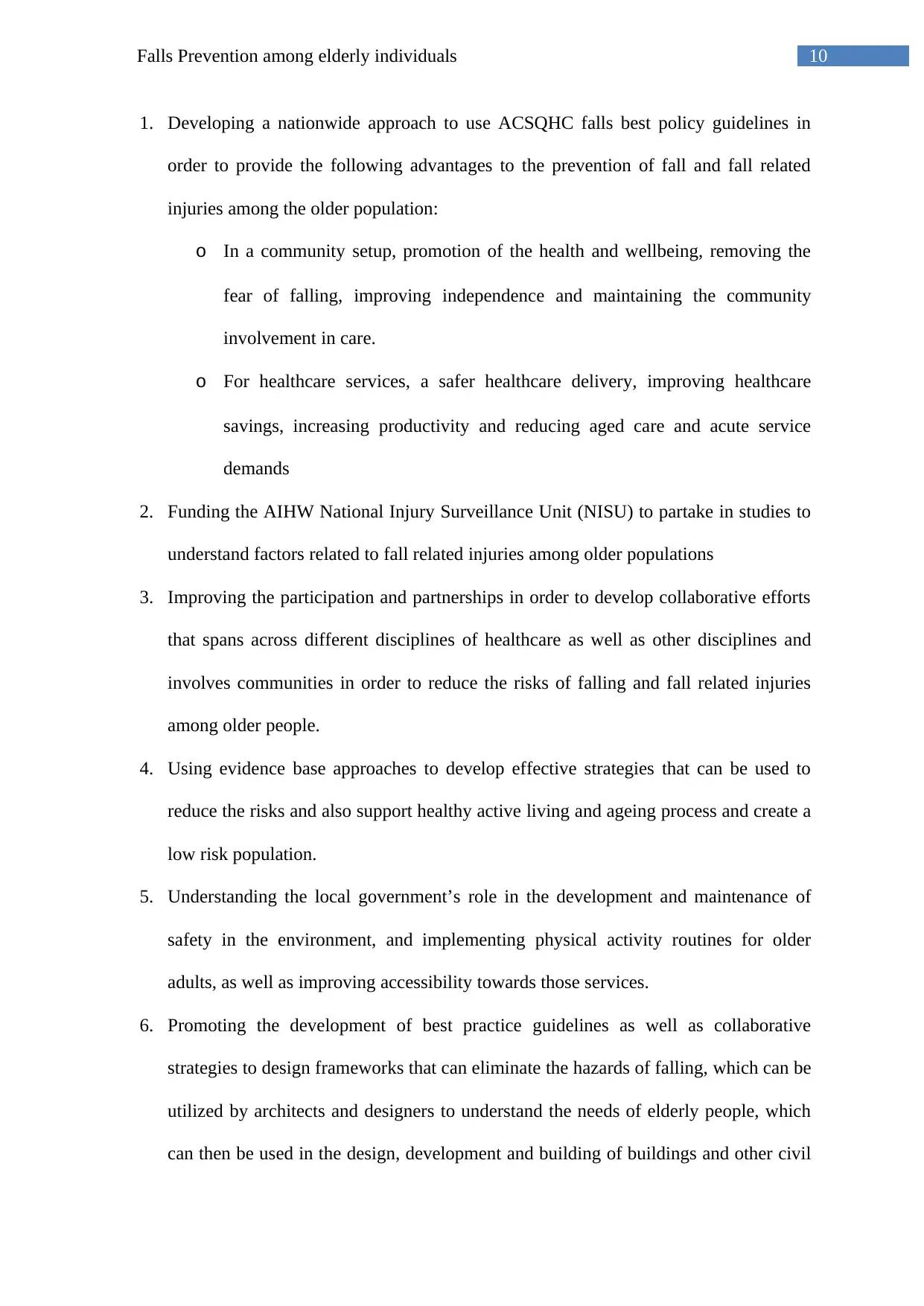
10Falls Prevention among elderly individuals
1. Developing a nationwide approach to use ACSQHC falls best policy guidelines in
order to provide the following advantages to the prevention of fall and fall related
injuries among the older population:
o In a community setup, promotion of the health and wellbeing, removing the
fear of falling, improving independence and maintaining the community
involvement in care.
o For healthcare services, a safer healthcare delivery, improving healthcare
savings, increasing productivity and reducing aged care and acute service
demands
2. Funding the AIHW National Injury Surveillance Unit (NISU) to partake in studies to
understand factors related to fall related injuries among older populations
3. Improving the participation and partnerships in order to develop collaborative efforts
that spans across different disciplines of healthcare as well as other disciplines and
involves communities in order to reduce the risks of falling and fall related injuries
among older people.
4. Using evidence base approaches to develop effective strategies that can be used to
reduce the risks and also support healthy active living and ageing process and create a
low risk population.
5. Understanding the local government’s role in the development and maintenance of
safety in the environment, and implementing physical activity routines for older
adults, as well as improving accessibility towards those services.
6. Promoting the development of best practice guidelines as well as collaborative
strategies to design frameworks that can eliminate the hazards of falling, which can be
utilized by architects and designers to understand the needs of elderly people, which
can then be used in the design, development and building of buildings and other civil
1. Developing a nationwide approach to use ACSQHC falls best policy guidelines in
order to provide the following advantages to the prevention of fall and fall related
injuries among the older population:
o In a community setup, promotion of the health and wellbeing, removing the
fear of falling, improving independence and maintaining the community
involvement in care.
o For healthcare services, a safer healthcare delivery, improving healthcare
savings, increasing productivity and reducing aged care and acute service
demands
2. Funding the AIHW National Injury Surveillance Unit (NISU) to partake in studies to
understand factors related to fall related injuries among older populations
3. Improving the participation and partnerships in order to develop collaborative efforts
that spans across different disciplines of healthcare as well as other disciplines and
involves communities in order to reduce the risks of falling and fall related injuries
among older people.
4. Using evidence base approaches to develop effective strategies that can be used to
reduce the risks and also support healthy active living and ageing process and create a
low risk population.
5. Understanding the local government’s role in the development and maintenance of
safety in the environment, and implementing physical activity routines for older
adults, as well as improving accessibility towards those services.
6. Promoting the development of best practice guidelines as well as collaborative
strategies to design frameworks that can eliminate the hazards of falling, which can be
utilized by architects and designers to understand the needs of elderly people, which
can then be used in the design, development and building of buildings and other civil

11Falls Prevention among elderly individuals
structures or architectures or to upgrade them. This can also help to create an
environment that fosters physical activity among the target group and also improve
the sense of security to partake in both planned and unplanned activities.
PHAA recommendations for Actions:
The PHAA outlines the following actions which has been resolved to reduce and
prevent the risks of falling and fall related Injuries. These actions can be applied by the board
and branches of healthcare organizations supported by advice from Injury Prevention Special
Interest Group, and include the following actions:
1. Supporting strategies to prevent injuries due to falling as a national health priority, which
aims to reduce the risks of falling, reduce injuries related to falling and its adverse effects
on elderly people using updated policy information which includes a strategy for policy
implementation.
2. Developing lobbies to increase funding in order to support health interventions, capacity
development to improve access to interventions based on evidences on fall prevention.
3. Supporting a systematic and multifaceted method of investment which can be used to
reduce the injuries related to falls, using evidence based strategies in order to foster
independent living for elderly people and also reduce future expenses and demands for
healthcare services.
4. Supporting strategies that foster collaboration between educators, researchers and policy
makers in order to develop research based on available evidence and the unmet needs,
and also to translate evidences based of literature into professional practice and to prevent
or reduce the risk of fall and fall related injury
5. Developing lobbies for resourcing in order to implement and fund the guidelines.
Recommended Updates:
structures or architectures or to upgrade them. This can also help to create an
environment that fosters physical activity among the target group and also improve
the sense of security to partake in both planned and unplanned activities.
PHAA recommendations for Actions:
The PHAA outlines the following actions which has been resolved to reduce and
prevent the risks of falling and fall related Injuries. These actions can be applied by the board
and branches of healthcare organizations supported by advice from Injury Prevention Special
Interest Group, and include the following actions:
1. Supporting strategies to prevent injuries due to falling as a national health priority, which
aims to reduce the risks of falling, reduce injuries related to falling and its adverse effects
on elderly people using updated policy information which includes a strategy for policy
implementation.
2. Developing lobbies to increase funding in order to support health interventions, capacity
development to improve access to interventions based on evidences on fall prevention.
3. Supporting a systematic and multifaceted method of investment which can be used to
reduce the injuries related to falls, using evidence based strategies in order to foster
independent living for elderly people and also reduce future expenses and demands for
healthcare services.
4. Supporting strategies that foster collaboration between educators, researchers and policy
makers in order to develop research based on available evidence and the unmet needs,
and also to translate evidences based of literature into professional practice and to prevent
or reduce the risk of fall and fall related injury
5. Developing lobbies for resourcing in order to implement and fund the guidelines.
Recommended Updates:
⊘ This is a preview!⊘
Do you want full access?
Subscribe today to unlock all pages.

Trusted by 1+ million students worldwide
1 out of 21
Related Documents
Your All-in-One AI-Powered Toolkit for Academic Success.
+13062052269
info@desklib.com
Available 24*7 on WhatsApp / Email
![[object Object]](/_next/static/media/star-bottom.7253800d.svg)
Unlock your academic potential
Copyright © 2020–2025 A2Z Services. All Rights Reserved. Developed and managed by ZUCOL.




